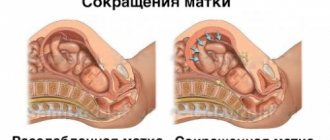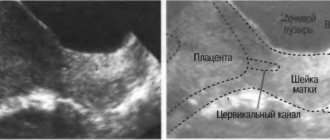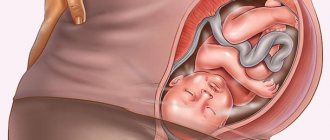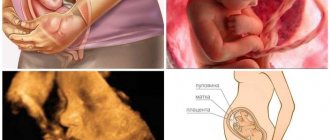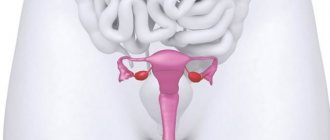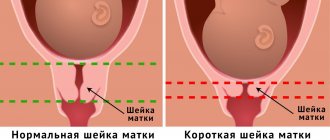The uterus, like other muscles of the body, is able to tense and relax. If the contraction of skeletal muscles can be regulated independently, then with the uterus the situation is more complicated. Activation of muscle fibers leads it to a state of hypertonicity, while the reproductive organ thickens and slightly enlarges. Let's look at how uterine tone occurs during pregnancy, symptoms, 2nd trimester week by week.
In the later stages of pregnancy, episodic tension is considered normal: this is how the woman’s body prepares for labor. The condition does not pose a danger to the mother and fetus and is called training contractions.
In other cases, symptoms of uterine tone in the second trimester manifest themselves as painful and prolonged contractions, which are accompanied by bloody discharge. This is considered a deviation and requires treatment.
Symptoms of uterine tone in the 2nd trimester by week of pregnancy
Week 14 During this period, the uterus has already increased sufficiently in size and can be felt above the pubic joint. The still small tummy protrudes forward.
At 14 weeks of pregnancy, any tension can result in a spontaneous miscarriage. Its symptoms are as follows:
- Bleeding from the genital tract;
- Frequent contractions of the uterus, following each other at intervals of several minutes;
- Severe pain in the lower back and lower abdomen.
The doctor determines incomplete dilation of the cervix and weakening of the muscular ring of the uterine pharynx.
Hypertonicity of the uterus during pregnancy can be provoked by any stress at home or at work, negative emotions - fear, anger, strong excitement.
Week 15. The baby is already actively moving in the stomach, but there are no sensations of kicking yet. At week 15, myometrial tension may occur due to constipation or excessive bowel activity.
Week 16 Signs of uterine tone in the second trimester manifest themselves in the form of discomfort and cramps in the abdomen. “It’s like you’re on your period,” the women say.
17-18 weeks. It is characterized by the baby’s rapid growth and rapid weight gain. This causes the uterus to stretch, becoming the size of a melon. At week 18, the woman experiences slight discomfort, which occurs due to the pressure of the uterus on the navel on the inside. If there is no pain, there is no need to worry.
19-20 weeks. The period is characterized by the beginning of fetal movement. Women carrying their first child may mistake the baby's kicks for manifestations of uterine tone. Movement at the 20th week of pregnancy is felt as intestinal peristalsis, a slight trembling that quickly passes.
Uterine tone differs from movement by a feeling of fullness and abdominal pain similar to menstrual pain.
The tone of the uterus during pregnancy can mask the baby's kicks, then the woman ceases to feel his movements. Weak movement is a threatening signal, so you should urgently visit a doctor.
21 weeks. The tension in the muscle layer appears and disappears. A woman experiences a feeling of a “lump” in her stomach. Unpleasant symptoms appear, as if “pulling the lower back.”
Week 22. During this period, rapid growth of the uterus is observed. It can periodically contract, these are the so-called “training contractions”. At 22 weeks of pregnancy, they are light, do not cause discomfort, and there is no vaginal discharge. The number of contractions can reach 10 times a day.
If contractions are accompanied by painful symptoms, a bloody discharge appears, this is regarded as a dangerous condition. The woman may need to be hospitalized in a hospital.
Hypertonicity of the uterus at 22 weeks can lead to early delivery. The cause of the pathological deviation is psychosomatic stress and inflammatory diseases. During this period, muscle contraction negatively affects the development of the child’s nervous system and brain.
Week 23. The woman describes her condition as a “stony womb.” During ultrasound, spasm and thickening of the myometrium are visible. The causes of uterine tone are various infectious agents: cytomegaloviruses, toxoplasma, influenza viruses.
Week 24. Hypertonicity can provoke impaired placental circulation and fetal hypoxia. In this case, the child develops poorly and is born with low weight.
Week 25. The tone of the uterus at the 25th week of pregnancy leads to the fact that the baby’s movements become painful for the mother. The baby begins to move rarely or, conversely, to move too actively.
Week 26. At this time, increased uterine tone indicates the following pathological abnormalities:
- Placental abruption;
- Threat of late miscarriage (or early onset of labor).
Uterine tone at 26 weeks of pregnancy is diagnosed quite easily. A woman is able to independently suspect a pathology, feel how the uterus is tense, “stands like a stake,” “turns to stone.” When examined by a doctor, the following signs of uterine tone in the second trimester are revealed:
- The abdomen is sensitive to any touch, as if tense;
- The pain is cramping in nature;
- Vaginal examination reveals a shortened and soft cervix, expansion of the cervical canal.
Symptoms
During pregnancy, the uterus receives significant stress, which leads to an increase in its size. And given the ability of the muscles of this organ to contract, during the initial stages of pregnancy this can cause a miscarriage.
With normal fetal ripening, the muscle tone of the organ is relaxed. Increased tone can be long-term or short-term. Small and short contractions should not cause concern, as they are a normal biological process of change in the female body before serious stress for it. It’s enough just to have a good rest and reduce physical and household stress.
Important! Hypertonicity of the uterus is possible against the background of subjective sensations of a pregnant woman who incorrectly interpreted her body’s reaction to external influences. Here, rather, the question is a psychological one. Tension of the muscles of the uterus for a long period of time can lead to undesirable consequences, so if such symptoms occur, you should immediately consult a doctor
With prolonged efforts, the muscles of the organ can cause abortion. This situation is extremely undesirable if the expectant mother is in normal physical and mental health.
Tension of the uterine muscles for a long period of time can lead to undesirable consequences, so if such symptoms occur, you should immediately consult a doctor. With prolonged efforts, the muscles of the organ can cause abortion. This situation is extremely undesirable if the expectant mother is in normal physical and mental health.
The first trimester of pregnancy is precisely the dangerous reaction of the female body to the processes of fetal formation. Therefore, the expectant mother needs to listen carefully to her body and be prepared to take the right measures to relieve the tone of the uterus.
Factors that can lead to increased uterine tone include various diseases and symptoms - diarrhea, sore throat, colpitis, convulsions, tachycardia, high blood pressure.
An increase in tone can be determined by the following factors:
- the occurrence of sharp pains in the lower abdomen, which are nagging or periodic in nature, as during menstruation;
- pain in the lumbar region;
- spotting red or brown vaginal discharge;
- sudden contractions when they should not yet be due to the stage of pregnancy;
- elastic and hard belly for no apparent reason.
Such symptoms are a clear reason to contact your gynecologist. In the first trimester, this can cause a miscarriage, and in the next stages of pregnancy, premature birth of a premature baby is quite possible.
A woman’s body usually adapts to the development of a new life for it, so pain in the lower abdomen is not always a symptom of an illness. Perhaps these are sensations from the expansion of the tissues of the uterus or pelvic bones. It is clear that any discomfort should be examined by a specialized doctor, which is why it is necessary to immediately contact the antenatal clinic at the first unpleasant sensation.
Important! Increased uterine tone can contribute to fetal freezing or oxygen starvation, which will lead to defective development of the child.
What to do if symptoms of uterine tone appear in the second trimester?
How to determine the tone of the uterus at home? To identify pathology, a woman just needs to lie on her back, pull her feet closer to her buttocks and feel her stomach. Normally it should be soft. Any tension or tightness in the abdominal wall indicates muscle tension.
Sign up for an appointment with the doctor
If the contractions are infrequent and do not cause much pain, treatment can be carried out on an outpatient basis. A prerequisite is compliance with bed rest and taking medications prescribed by the doctor.
The appearance of multi-colored vaginal discharge (pink, brown, yellowish, dark) is regarded as bleeding. The woman needs inpatient observation; at the doctor’s discretion, drip administration of medications is used in the 2nd trimester.
If uterine tone is detected during pregnancy, the symptoms of the 2nd trimester largely depend on the state of the woman’s nervous system. If it is weak and sensitive to any changes, then all manifestations will be acute. Sometimes symptoms of uterine tone in the second trimester mimic renal colic, then paroxysmal pain in the lumbar region, difficulty urinating, nausea and vomiting appear.
Renal colic develops in pregnant women due to impaired salt metabolism, leading to hypertension and premature birth of the baby. Urinalysis and ultrasound examination of the abdominal organs will help to recognize both conditions.
With a stable nervous system, myometrial tension may not be accompanied by any special signs; the tone of the posterior wall of the uterus is detected during a routine examination and ultrasound.
During the study, the condition of the placenta is assessed, the baby’s heartbeat and possible defects in its development are determined. There is a special apparatus for measuring the strength of muscle contractions, but it is not found in every clinic and is not widely used. The symptoms of tone are already quite characteristic. As an additional study, cardiotocography and Doppler ultrasound are prescribed in order to clarify the health of the fetus.
In addition to instrumental methods, blood tests for hormones (thyroid, prolactin, androgens) are performed. What is dangerous about tone is uterine bleeding. Therefore, it is necessary to assess the state of hemostasis - the blood coagulation and anticoagulation systems.
Drug treatment
In the 2nd trimester the following drugs are used:
- Herbal sedatives based on motherwort, valerian, Magne B6;
- To relieve spasms - No-shpa, Papaverine, Drotaverine. No-spa is a safe medicine for pregnant women and can be used throughout the entire period of pregnancy;
- Calcium channel blockers (Nifedipine), they prevent muscle contraction and eliminate uterine tension;
- To normalize metabolic processes, Actovegin, Riboxin, Cocarboxylase are used;
- Magnesium sulfate.
How to avoid uterine tone
Before you start taking medications to normalize your condition, you should try to change your lifestyle. Sometimes this is quite enough to relieve hypertension and bring the general well-being of the expectant mother back to normal.
Gynecologists recommend:
- The expectant mother should get proper rest every day. You cannot engage in physical labor, sports, or move for a long time without rest. A girl should get enough sleep, rest and relax. But at the same time you need to walk, breathe fresh air, swim, and do breathing exercises.
- Avoid lifting heavy objects, prolonged heavy loads and physical labor. All actions of the expectant mother should not cause discomfort. You can do light housekeeping, cooking, walking, pregnancy exercises and swimming.
- Reduce sexual activity. If a girl has been diagnosed with this, she will have to give up sex for a long time. Sexual activity can intensify pathological processes and lead to complications.
What to do if conventional methods do not help? If preventive measures do not produce positive results, the gynecologist prescribes medications to the woman to normalize her tone. Most often, drugs are prescribed in the form of suppositories. The dosage and course of use are determined by the attending physician.
Typically, in complex treatment, the following groups of drugs are prescribed:
- natural sedatives (valerian, motherwort, calendula);
- droppers with Magnelis B6;
- agents that reduce hypertension (Papaverine, No-shpa).
Self-medication is not recommended, as this is fraught with unpredictable consequences. Therefore, if the first symptoms of the disease appear, you should first consult a doctor. Perhaps the girl will be scheduled for a repeat ultrasound to find out how the fetus is developing. If there is no risk of complications, the gynecologist will give recommendations on how to normalize the condition and, if necessary, prescribe a course of medication.
What other causes of increased tone are there and how to prevent them are shown in the video:
Why is uterine tone dangerous in the 2nd trimester?
Increased uterine tone in the second trimester threatens miscarriage, feto-placental insufficiency, frozen pregnancy and uterine bleeding. When muscle spasms occur, the child does not receive enough nutrients and oxygen. Therefore, the tone of the uterus is dangerous due to delayed growth and intrauterine development of the baby.
Is uterine tone dangerous in the second half of pregnancy? If there is no treatment, there is a possibility that the baby will be born prematurely.
Normal contractile activity of the uterus contributes to a successful outcome of childbirth. According to statistics, Russian doctors diagnose every second pregnant woman with increased uterine tone. This diagnosis is associated with disturbances in pregnancy and fetal development.
• What sensations does a woman experience with increased uterine tone?
The main sensations with increased uterine tone in a pregnant woman are:
- 1. unpleasant squeezing or aching pain in the lower abdomen (pain with increased tone can be both strong and barely noticeable); often the pain is similar to that characteristic of a woman during menstruation;
- 2. abdominal tension (feelings of hardness, stoneness in the abdomen);
- 3. often – pain or discomfort in the lumbar and sacrum areas.
All these sensations are signs of increased uterine tone, which threatens the normal course of pregnancy. Let us repeat: if the pain becomes cramping and periodic or bleeding appears, call an ambulance immediately!
What is uterine tone, danger in later stages
The uterus is the main organ of a woman’s reproductive system, in which the embryo develops and the unborn child is born. The middle layer of the uterus, called the myometrium, consists of smooth muscle fibers. During pregnancy, it increases in both mass and volume. The relaxation and contraction of muscle fibers is controlled by impulses from the central nervous system and regulated by hormones. Doctors consider infrequent (no more than five times a day) and short-lived (2-3 minutes) uterine contractions natural in the second trimester and early third. And increased excitability of the smooth muscles of the myometrium is defined as a pathology and is called hypertonicity.
The walls of the uterus consist of three layers, of which the middle one is smooth muscle fibers
Hypertonicity can be both a symptom and a cause of pregnancy complications. In the later stages, it can signal the following violations:
- uterine fibroids;
- uterine polyps;
- placental abruption;
- inflammation of the endometrium.
Frequent and intense tone itself can lead to placental abruption and disrupt uterine circulation, which increases the likelihood of developing the following complications in the second and third trimester:
- threat of late miscarriage;
- fetal hypoxia;
- intrauterine growth retardation;
- premature birth;
- fetoplacental insufficiency;
- isthmic-cervical insufficiency.
The presence of bloody discharge from the genital tract, lack of fetal movements, increased uterine tone may indicate injury to the uterus, fetus and placenta.
E.K. Ailamazyan, V.I. Kulakov
"Obstetrics"
What it is?
Tone or hypertonicity is the name given to increased excitability of the smooth muscles of the uterus. Calm and relaxed three layers of the uterine walls are the key to normal gestation until childbirth. Then, under the influence of oxytocin, the myometrium begins to contract during the dilatation of the cervix - these are labor pains.
The tone in the second trimester is too early for labor. Therefore, the condition is classified as pathological. The exception is false contractions, which can appear in first-time mothers after the 20th week of pregnancy. They are manifested by short-term, infrequent tension of the uterus, which lasts from several seconds to several minutes, after which the uterus relaxes.
Increased uterine tone is mainly associated with hormonal changes or any unfavorable psychological, emotional, psychophysiological factors.
Most often, women who have not reached the age of 18-19 years at the time of pregnancy, as well as women over 34 years old, complain about the tone of the uterus during pregnancy. Early pregnancy at too young an age occurs against the background of underdevelopment of the genital area and insufficient readiness of the reproductive organ to bear a child. Pregnancy over the age of 34 has its own characteristics, and women often approach this age with a history of several abortions, the presence of infectious or inflammatory diseases in the present or past, and a difficult birth in their personal medical history.
Causes of tone
Among the main reasons for increased uterine tone during gestation, obstetricians-gynecologists consider:
- hormonal imbalance;
- dysfunction of the autonomic nervous system;
- increased internal pressure on the walls of the uterus;
- diseases of the genital organs;
- chronic illnesses;
- lack of vitamins and microelements.
Insufficient production of progesterone increases the contractile activity of the myometrium. It is this hormone that reduces the excitability of receptors in the uterus and brain. Throughout pregnancy, stress, nervous shock, fatigue and physical exertion lead to disturbances in the functioning of the central nervous system, which also affects the uterus. Infections of the genital organs (herpes, chlamydia, gonorrhea) cause inflammatory processes in it. Factors that increase the risk of hypertension include the presence of diabetes mellitus, obesity, and constant high blood pressure in a pregnant woman.
Second trimester
In the second trimester, from about the 20th week, a woman may experience so-called Braxton-Hicks contractions. Their intensity and frequency are low, but when combined with provoking factors, they can cause increased uterine tone. During the same period, magnesium deficiency may occur in the body, which contributes to the occurrence of smooth muscle spasms.
Third trimester
In the third trimester, additional factors leading to hypertonicity include:
- large fruit;
- multiple pregnancy;
- polyhydramnios.
They create excess internal pressure on the walls of the uterus and provoke contractile activity of the myometrium.
Last weeks of pregnancy
Two to three weeks before the expected birth, progesterone levels drop and estrogen levels increase. Therefore, the intensity of training or false contractions increases. This is a sign of the body’s immediate preparation for childbirth.
When can it develop
1st trimester
At this time, an increase in muscle tension indicates a possible termination of pregnancy. The occurrence of pathology is influenced by:
- sexual contacts,
- physical exercise,
- stress,
- bowel movement disorders,
- toxicosis.
2nd trimester
In the second trimester, the pathological tension of the reproductive organ is more pronounced. Possible reasons:
- high water content,
- presence of twins,
- development of fibroids,
- endometriosis,
- blood rhesus discrepancy,
- pathology of placenta position,
- inflammatory phenomena in the female genital organs.
3rd trimester
Before the 35th week of gestation, the appearance of muscle tension is undesirable. Causes of the pathological condition:
- pathology of the child's position,
- gestosis,
- placental insufficiency,
- a history of cesarean section,
- possibility of miscarriage.
Diagnostics
The assumption of hypertonicity can be made by the doctor already at the stage of interviewing the pregnant woman, during which the latter talks about her feelings. The diagnosis is clarified using a medical examination and special equipment.
Palpation
During the examination, the woman should lie on her back and bend her knees to eliminate tension in the abdominal muscles. An obstetrician-gynecologist evaluates the existing lumps and their location by palpating the abdomen.
Palpation (palpation) of the pregnant woman’s abdomen is the main method for diagnosing uterine hypertonicity
Tonuometry
The contractile activity of the myometrium is checked using modern cardiotocographs. For this purpose, the indirect method of cardiotocography is used, in which a special strain gauge sensor is applied to the pregnant woman’s abdomen. The sensor signals indicate the tension of the uterine walls.
Symptoms of pathology
The signs of the disease are easy to determine yourself.
In the first trimester they look like this:
- pain in the lower abdomen: weak, aching, pulling or severe, cramping;
- there is discomfort in the lower back;
- heaviness, a feeling of elasticity, hardness appears in the lower abdomen;
- cramping urges after a certain period of time;
- spotting and bleeding may appear.
At a later stage, it is even noticeable how the stomach shrinks. But sometimes the pathology is asymptomatic.
If there is pain in the lower back, lower abdomen and there is spotting, this may indicate the tone of the posterior wall of the uterus, which indicates the onset of pregnancy complications.
If there are no visible symptoms, hypertension can be determined in this way:
- Lie on your back and relax.
- Feel your stomach with your hands.
- If it's soft, there's no problem.
- If you have a hard, elastic stomach, you should see a gynecologist.
Minor pain and a feeling of heaviness in the abdomen in the first weeks of the gestational period do not always indicate pathology. In most cases, this is caused by a restructuring of the woman’s body in connection with its global preparation for the development and gestation of an embryo. This lasts until 11–13 weeks, then the symptoms stop bothering you.
In any case, at the very first symptoms, you must notify the doctor, and he will prescribe a full examination and determine whether there is an illness or not. Once the diagnosis is confirmed, the doctor will prescribe treatment.
What treatment is possible
Therapy for increased tone is carried out by eliminating its causes, using symptomatic medications and rationalizing the daily routine. Hypertonicity of the second degree is treated in a hospital setting. For therapy to be effective, complete physical and emotional rest is ensured, and bed rest is recommended.
Drug treatment
For progesterone deficiency, hormonal drugs are prescribed: Duphaston and Utrozhestan. In case of fetoplacental insufficiency, Curantil and Actovegin can be used. No-Shpa and Papaverine are used to quickly relieve spasms. Nervous excitement is eliminated with valerian remedies. If there is a threat of premature birth, Ginipral is indicated, which relaxes the muscles of the uterus. Hypertonicity is also relieved with magnesium preparations: Magnesium sulfate and Magne-B6.
Exercises to relieve tone
You can relax your uterus with relaxation exercises. To do this, just try to relax your facial muscles first, then your neck, back, arms, legs and stomach. In this case, breathing should be quiet and calm. It is better to do the exercise while lying in a secluded place with your eyes closed.
To eliminate hypertonicity, an exercise called “cat” is also recommended. Standing on all fours, you should slowly bend your back down and then arch it up. Sometimes it’s enough just to stand on all fours for a few minutes, relaxing the muscles of the whole body.
You can relieve increased tone during pregnancy using the “cat” exercise
Nutritional Features
Drinks such as coffee and black tea increase the tone of the uterus. Eggs, fish and meat must be subjected to sufficient heat treatment, since in their raw form they contain a large number of pathogenic bacteria and fungi, which can cause hypertension. In your diet you need to limit the consumption of spices and medicinal herbs. The menu should contain more fresh vegetables, fruits, and cereals, which normalize the functioning of the intestines, since constipation can trigger uterine contractions. Magnesium is naturally found in nuts, buckwheat, oatmeal, beans, and bran bread.
Folk remedies
Tea with lemon balm is safe for expectant mothers. This herb has a general calming effect on the pregnant woman’s body, including the uterus. Parsley decoction effectively relieves spasms. To generally strengthen the immune system and prevent hypertension, folk healers recommend drinking a decoction of dried apricots, raisins and rose hips (take 30 mg of each ingredient per liter of water).
Treatment and prevention
Each pregnant woman with this diagnosis is prescribed bed rest, sedatives that reduce spasms and general activity of the uterus.
More often, treatment is carried out in a hospital. First of all, sedatives are prescribed, because the stress associated with the possibility of termination of pregnancy further increases the tone of the uterus.
Hypertonicity is relieved by taking special medications. If there is a lack of progesterone, Utrozhestan or Duphaston are prescribed.
All kinds of antispasmodics, such as No-Shpa or Papaverine, are quite effective in combating uterine tone. During treatment, monitoring of sugar, heart rate and blood pressure is required.
Prevention of uterine hypertonicity during pregnancy
You need to think about preventing increased tone even when planning a pregnancy. You should try to get rid of infectious and chronic diseases. During gestation, it is better to postpone serious plans for work, home repairs, and moving. You need to avoid anxiety and heavy physical activity.
According to the wife, the tone of the uterus during the first and second pregnancies did not particularly bother her. It occurred during prolonged standing, lying on the back, and during ultrasound. It was during the ultrasound that hypertonicity caused the greatest discomfort. My wife says that my stomach felt like it was turning to stone. To eliminate it, it was not enough to simply lie down for 20–30 minutes on the left or right side. I had to take additional Magne-B6. The main thing is that the wife always had the opportunity to lie down if necessary, since she decided to temporarily sacrifice her career and left work. The work brought a lot of excitement, caused stress and was accompanied by fatigue. All her friends who tried to combine pregnancy and work had increased tone. Some of the friends had to be treated in a hospital, although they had no special reasons for hypertension in the form of chronic diseases or hormonal imbalance.
Reasons for threatened miscarriage in the second trimester
Hypertonicity of the uterus, associated with the threat of miscarriage, can be caused by a variety of reasons. These can be problems both from the mother (infections, various chronic diseases) and from the fetus (congenital malformations, hypoxia). Often, uterine tone is caused by pathologies of the hematopoietic system, leading to blood thickening. In all these cases, it is necessary to conduct a complete examination of the woman. Doppler ultrasound is the easiest way to assess the condition of the fetus and placenta. Based on the results of the examination, the doctor prescribes treatment aimed at maintaining the current pregnancy.
Reviews from women
Throughout my pregnancy I was diagnosed with hypertonicity, my stomach was constantly tense, they persuaded me to lie down in the hospital, I lay down once when they first told me to, then I just tried to rest more, lie down, drank Magne B6, they thought I’d had an erysipelas earlier - I even went over.
Olka-octopus
https://forum.materinstvo.ru/index.php?view=findpost&showtopic=10372&p=6020933
For weeks from 4 to 5 months she was in storage, but it manifested itself like this: a lump was compressed in the stomach, so hard, when the stomach was already visible, the stomach became a stake, like a stone, I couldn’t sleep on my back, it immediately became a stake, I slept mostly on my side , be less nervous, and motherwort helped me a lot.
lapuska
https://forum.sakh.com/?sub=812290&post=21059708#21059708
In the early stages they removed my tone with duphaston, after 20 weeks with ginipral, although there was no particular tone, the doctors are now playing it safe.
Kitty
https://www.woman.ru/health/Pregnancy/thread/4123157/1/#m31536765
At work, I half-lye down on a chair, close my eyes and breathe with my stomach. The main thing here is to relax the facial muscles as much as possible, well, almost to the point of a retard, and breathe loudly enough, well, honestly, it really helps, it’s something out of yoga. I haven’t done it myself, but I heard it somewhere and I do it. Only I have not so much tone, but training contractions.
Vikson
https://www.u-mama.ru/forum/waiting-baby/pregnancy-and-childbirth/353208/
Currently, medicine has a sufficient range of tools to neutralize the negative effect of increased uterine tone. Therefore, with timely diagnosis and proper therapy, the prognosis in the vast majority of cases is positive.
For pain and tension in the abdomen, doctors often diagnose uterine tone during pregnancy in the 2nd trimester. For some patients, this condition does not pose a danger and is a physiological reaction. For others, it can threaten premature placental abruption and early labor. To determine why tone is dangerous and whether it is necessary to fight it in this case, you need to contact a gynecologist and do an ultrasound.
Features of the pathology
As a rule, mid-pregnancy is the easiest and most favorable period. Early toxicosis has already passed, the body is already accustomed to new changes. However, sometimes the process of bearing a baby can be complicated by increased tension in the uterus in the second trimester. This condition seriously harms the fetus, especially if it occurs frequently (more than 5 times a day).
If the treatment of pathology
for some reason it fails, in most cases the baby can be saved (a particularly high survival rate is observed after 28 weeks, when all organs of the fetus are fully formed, especially the lungs).
Read more Herpes in infants
Therefore, if this condition causes early labor, it may not harm the baby or mother. The main thing is to consult a doctor in a timely manner to avoid unpleasant consequences.
The reasons for tone from the 16th week can be different, but most early labor occurs precisely because of contractions of the reproductive organ, which often appear much earlier than the due date.
How to determine the tone of the uterus. This phenomenon is a petrification of the lower abdomen, which causes some discomfort . If he rarely appears, the woman most likely will not notice him. If a pregnant woman detects signs of uterine tone in the second trimester, she will definitely need to see a doctor to undergo examination and, if necessary, treatment. This will avoid complications, which, as a rule, negatively affect the baby’s health.
Causes
The cause of uterine tone in the second trimester of pregnancy can be physiological and pathological factors. The cavity of the reproductive organ consists of several layers. The intermediate layer is the myometrium - muscle. It performs an important function for the pregnant woman and the unborn child: during pregnancy it allows the organ to stretch and remain calm, and during childbirth it contracts and helps push out the newborn.
Periodically increased uterine tone in the 2nd trimester is normal.
Since the organ is muscular, it needs training. At about 20 weeks of pregnancy, a woman may experience training contractions. The main difference from the true ones is the absence of pain and frequency. You should be concerned if the contractions are repeated after the same amount of time and become more frequent. The causes of uterine tone in the 2nd trimester can be divided into physiological and pathological:
- physical activity - at the 18th week of pregnancy, a woman’s tummy begins to rapidly increase in size, and with exercise, tension in the abdominal wall becomes clearly noticeable;
- stress – during stress, the body produces cortisol and adrenaline, which are unusual for a pregnant woman;
- progesterone deficiency - in the 2nd trimester, the pregnant woman is usually already familiar with the sensations signaling hormone deficiency and takes medications for correction;
- cervical insufficiency - a condition in which the cervix dilates ahead of schedule;
- intimate intimacy - during orgasm, contraction of the reproductive organ occurs, resulting in signs of uterine tone.
Unpleasant sensations can be caused by off-road driving, doing household chores, walking too long, or disruption of the digestive tract. Usually these provocateurs do not pose a danger if they are not repeated regularly.
Causes
Changes in the tone of the uterus may depend on various factors, because each human body is individual. And when changes occur in him, he must adapt to them. A woman’s body changes significantly before childbirth, and this applies to both physiology and psychology.
Physiological factors
A woman's body can react in a variety of ways to changes in its physical structure. Here are the most general reasons for the reaction of the reproductive system to gestation:
- stressful situation;
- excessive physical activity;
- insufficient rest - general lack of sleep, late bedtime, early rise;
- long and active sex;
- toxicosis or poisoning;
- disruption of the gastrointestinal tract;
- inflammatory processes of the genitals with pain, discharge and itching;
- bad habits that you couldn’t get rid of when planning a pregnancy.
Familiarize yourself with the changes in the female body during the second and third trimester of pregnancy
Psychological factors
There are a huge number of possibilities for the human body. Even a mentally balanced woman with such powerful changes in her body can significantly change her psychological portrait.
Here, it is possible to make illogical decisions, groundless outbursts of emotions and other attributes of responding to changes in the body. It is also worth considering the age range - women under 18 years of age and over 30 years of age are more vulnerable psychologically, and their reaction to uterine contractions is often unpredictable.
Did you know? As a girl matures, her uterus is formed from two tubes that eventually join together. However, in exceptional cases this does not happen, and some women have two uteruses.
Among other reasons, uterine contractions can be caused by insufficient presence of the hormone progesterone in the body. It regulates the tension of this organ during pregnancy, and an insufficient amount of it can provoke an early miscarriage.
How to determine the tone of the uterus during pregnancy yourself
Diagnosis of uterine tone in the second trimester of pregnancy should be carried out by a doctor. The expectant mother can conduct an independent examination at home. It is not difficult to recognize the tone of the uterus. However, you will not be able to assess the severity of the current situation on your own. Only a doctor can tell you whether the tone of the uterus is dangerous. As soon as the expectant mother realizes that she has tone, she must immediately inform her local gynecologist about her condition.
How to determine the tone of the uterus during pregnancy?
- You need to take a comfortable position. If you lie down, you can see the contractions better. In a sitting position, a pregnant woman feels contractions more than sees and touches them.
- You should place your palms on your stomach and relax. Breathing should be smooth and your emotional state should be calm.
- Within a few minutes you need to observe the behavior of the tummy. Tone is muscle tension. The next episode will be accompanied by a feeling of pressure in the perineum and a visual change in the shape of the tummy. Many women compare an episode of uterine hypertonicity with a petrification of the abdomen.
Sometimes it happens that after self-diagnosis, the disturbing signs go away. In this case, the tone of the uterus is not dangerous. If, at rest, tension in the anterior abdominal wall and pressure in the pelvic cavity disappear, then these symptoms are a physiological reaction. However, you should still inform your gynecologist about them.
With symptoms and signs
In different women, signs of uterine tone during pregnancy may have a distinctive intensity - symptoms in the 2nd trimester are more noticeable than in the first. This is explained by the fact that the reproductive organ expands and reaches the navel area by mid-term.
The uterus occupies most of the abdominal cavity and, when tense, causes a vivid clinical picture:
- discomfort in the lower abdomen, reminiscent of premenstrual pain;
- an increase in the volume of vaginal discharge, the presence of mucus and blood streaks;
- feeling of heaviness in the stomach;
- painful lumbago in the lumbar area;
- discomfort in the pubis and perineum.
In rare cases, there are no signs of uterine tone in the second trimester, and the problem is discovered by chance. If in the first trimester women cannot always distinguish the signs of pathology from natural processes, then in the 2nd trimester they become more pronounced.
Diagnostics
Examination of the expectant mother for tone in the second trimester of pregnancy is carried out using ultrasound and gynecological examination. Initially, when reporting complaints, the doctor palpates the woman’s tummy. In the 2nd trimester, it already rises significantly above the womb and allows you to identify the problem immediately. Regardless of whether the tone is confirmed or not, the woman is recommended to undergo additional ultrasound examination. The frequency of uterine tone during pregnancy in the second trimester is unpredictable. The doctor may not find any cause for concern and say that there are no risks, and the woman will experience contractions again at home. Therefore, all patients with complaints of pain and tension in the abdomen are prescribed an ultrasound scan.
In the 2nd trimester of pregnancy, the examination is performed with a probe through the abdominal wall.
This avoids additional stimulation of uterine activity. If there really is tone, an ultrasound shows that one or all of the walls are under tension - thickened. During diagnosis, the condition of the internal pharynx and cervix is also assessed, which allows us to judge the danger of this condition.
Removing tone at home
The best way is exercises to relieve uterine tone. For example, the “Cat” exercise: we get on all fours, raise our head and arch our back, stand in this position for several seconds, and then slowly return to the starting position. You need to repeat this exercise several times and then lie down for an hour.
Relaxing the facial muscles helps relax the uterine muscles. Therefore, the second exercise, which is recommended to be done to tone the uterus, is related specifically to the face. We lower our heads and relax all the muscles of the face and neck as much as possible. When performing it, you need to breathe only through your mouth.
To get rid of the symptoms of hypertonicity and the resulting unpleasant sensations, sometimes it is enough to simply get on all fours with emphasis on your elbows, in the so-called knee-elbow position.
By combining this simple set of exercises with antispasmodics and a sedative, you can quickly relieve the tone of the uterus. However, we must not forget that it is important not only to relieve the tone of the uterus, but also to eliminate the cause. For this, it is very important to strictly follow all the instructions of the attending physician. If this condition cannot be relieved, or the discomfort intensifies, you will have to agree to hospitalization.
M drug treatment
Assessing the strength of uterine hypertonicity during pregnancy, the specialist prescribes outpatient or inpatient treatment. If there is concern for the life of the child or there is a possibility of premature birth in the 2nd trimester, the pregnant woman is hospitalized. A woman may also be admitted to the pathology department if she has severe pain.
To get rid of uterine tone during pregnancy in the 2nd trimester, an integrated approach to therapy is chosen.
- Regime and diet. The expectant mother is advised to rest completely. This applies not only to physical activity, but also to emotional activity. Sexual contacts must be avoided completely. Any stimulation of the uterus is prohibited. Increased or decreased bowel activity can also cause the organ to contract. Therefore, the woman is prescribed a diet and drinking regimen. Regular bowel and bladder movements help relax muscles and relieve tension in the uterus.
- To return the muscle layer of the reproductive organ to its normal state, tocolytic therapy is carried out. It involves the use of medications to prevent premature birth. The list of such drugs includes Nifedipine and Ritodrine.
- To eliminate the spasm, Papaverine and No-Shpa are prescribed. These products are suitable for long-term use and do not have a negative effect on the fetus.
- Sedatives are mandatory in the treatment of uterine tone in the 2nd trimester. Usually a pregnant woman is prescribed Motherwort tincture or Valerian tablets. Magnesium B6 or magnesium sulfate has a positive effect on the nervous system and muscles.
- To prevent fetal hypoxia and normalize blood flow, the drugs Curantil and Actovegin are prescribed, approved for use in the 2nd trimester of pregnancy.
- If diagnostics show that the cause of tone is a lack of progesterone, hormonal therapy is prescribed. Typically, it is needed by patients whose pregnancy is less than 22 weeks.
- For isthmic-cervical insufficiency detected in the 2nd trimester, wearing a pessary or suturing the cervix is prescribed.
Patients at risk are prohibited from sex and physical activity until childbirth.
Progesterone and FPS
Hormones are also responsible for the normal course of pregnancy. For up to ten weeks, one of the most important roles is played by progesterone, a hormone in women produced in the ovary by the “corpus luteum.” VT appears at the place where the egg is released and sent into the uterine tube. It then transforms into the corpus luteum of pregnancy, actively promoting the production of estrogen and progesterone for up to ten weeks. After this period, VT decreases along with the synthesis of progesterone.
Progesterone is important for pregnancy and normal uterine tone. It reduces the ability of muscles to contract and also reduces intestinal tone. This is why many pregnant women suffer from constipation. Progesterone also affects the central nervous system, due to which many expectant mothers often suffer from drowsiness.
The FPS is the fetoplacental system, which consists of the liver, adrenal cortex, placenta of the woman and the child. FPS promotes the production of estriol, a hormone that helps regulate blood circulation in the uterus and placenta. When the production of estriol is disrupted and the FPS is not functioning correctly, anomalies occur in the development of the child.
Why is uterine tone dangerous in the 2nd trimester?
Increased activity of the uterus of the 2nd degree is accompanied by severe abdominal pain and periodic tension of the abdominal wall. For a woman, this condition usually does not pose a threat, which cannot be said about the unborn child. With repeated muscle contraction, metabolic processes are disrupted, blood circulation between the fetus and placenta changes, and a deficiency of oxygen and other substances necessary for development occurs.
Expectant mothers often note that when this clinical picture appears in the 2nd trimester, the child becomes more active. This is explained by the fact that the baby is trying to stimulate the placenta with its movements. The child instinctively massages the baby's place, forcing it to work as before.
Constant tone can lead to unpleasant consequences:
- oxygen starvation;
- cerebrovascular accident;
- intrauterine growth retardation;
- birth of a low birth weight baby;
- fetoplacental insufficiency.
Premature separation of the placenta is especially dangerous when the uterus is early. The result is massive internal bleeding. In the absence of medical care, a rapid death usually occurs for the baby and there is a risk of death for the mother.
Contraction of the uterus can lead to premature birth. Wall tension causes expansion of the internal os and contraction of the cervical canal. Pressure on the amniotic sac from the inside can cause rupture of amniotic fluid.
If you seek medical help in a timely manner, the tone of the uterus does not pose a serious threat. Doctors quickly choose a course of action that depends on the duration of pregnancy and the initial condition of the patient, which makes it possible to prolong the pregnancy until the desired period.
Forecasts
Despite the description of the rather terrible consequences of hypertonicity, in practice the prognosis is usually assessed as quite favorable. If medical care is provided in a timely manner, then in 99% of cases it is possible to relieve the increased excitability of the uterine muscles in time and prolong pregnancy not only until the expected date of birth. Often, women who suffered from hypertonicity in the middle of pregnancy and received treatment carry the child to term and give birth only at 42-43 weeks.
Experts believe that pregnancy is prolonged “due to nervousness” - the more a woman was worried about the safety of pregnancy, the more chances she has for a psychogenic prolonged pregnancy.
If a woman refuses treatment and hospitalization, no one will give a forecast, because no one can predict how the woman’s central nervous system and uterine smooth muscles will behave.
There are cases when, due to the tone against the background of stress, a woman can only be helped by eliminating the stress factor. It is also possible that the tone will be maintained for a long time, which will increase the chances of fetal hypoxia, in which its brain and heart function may be affected, and intrauterine growth retardation may develop.
For more information about the symptoms of uterine tone during pregnancy, see the following video.
- Second trimester
- Screening
- Ultrasound
- TSH
- Hemoglobin
- Uterine tone
- Nutrition
- Gymnastics
medical reviewer, psychosomatics specialist, mother of 4 children
The uterus, like other muscles of the body, is able to tense and relax. If the contraction of skeletal muscles can be regulated independently, then with the uterus the situation is more complicated. Activation of muscle fibers leads it to a state of hypertonicity, while the reproductive organ thickens and slightly enlarges. Let's look at how uterine tone occurs during pregnancy, symptoms, 2nd trimester week by week.
In the later stages of pregnancy, episodic tension is considered normal: this is how the woman’s body prepares for labor. The condition does not pose a danger to the mother and fetus and is called training contractions.
In other cases, symptoms of uterine tone in the second trimester manifest themselves as painful and prolonged contractions, which are accompanied by bloody discharge. This is considered a deviation and requires treatment.
About general tips
To prevent tone, it is recommended to exclude physical and emotional stress. If there are no contraindications, you should spend more time in the fresh air during pregnancy. For proper muscle function, a healthy diet and the absence of bad habits are important. Positive emotions ensure the normal course of pregnancy.
Women who experience tone in the 1st trimester should be especially careful about their situation. It is necessary to regularly take the medications prescribed by the doctor and avoid intimate relationships.
If during pregnancy, while doing housework or after a long walk, signs of tone appear, you need to rest. At rest, you can better monitor the behavior of your tummy. If the tone does not go away within half an hour or its symptoms intensify, you should go to the hospital.
Causes of the disease
A toned uterus during pregnancy in the 1st trimester occurs for various reasons. There are two main categories - physiological basis and psychosomatic basis.
The physiological reasons are as follows:
- past abortions;
- large fruit;
- multiple births;
- polyhydramnios;
- infantility of the uterus (underdevelopment);
- complications during pregnancy;
- diseases of the endocrine system;
- infections;
- excessive physical activity;
- age of the expectant mother;
- bad habits;
- unbalanced diet;
- gastrointestinal diseases, constipation, flatulence;
- thyroid diseases;
- sexual intercourse;
- excessive toxicosis;
- excess male hormones or insufficient amount of progesterone;
- Rhesus conflict;
- cancer diseases.
Psychosomatic causes include:
- lack of sleep;
- stress;
- emotional stress;
- experience.
Any negative emotions can lead to contraction of the uterine muscles, so during gestation a woman should avoid conflict situations and try to always be calm.

